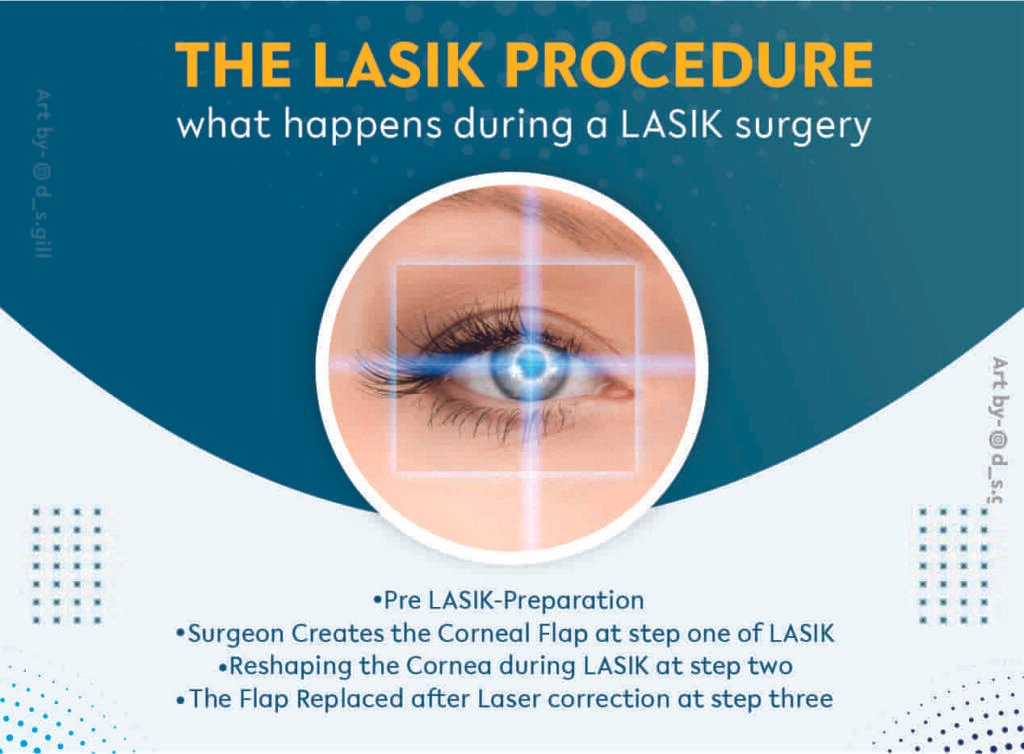LASIK eye surgery is a prime example of the wonders of contemporary medicine in the field of vision correction. For millions of people who wish to live without glasses or contact lenses, it is a ray of hope. However, what precisely occurs during this process of transformation? This blog explores the steps of how LASIK eye surgery is done. The best eye surgeon in Bathinda, Dr. Kashish Gupta, provides a detailed, easy description of LASIK Eye Surgery to educate anyone thinking about this potentially life-altering procedure, which allows you to live a spectacle-free life.
Pre-surgical assessment is essential
A comprehensive pre-operative evaluation of prospective patients is required prior to your LASIK procedure. This vital stage includes a thorough eye exam to make sure the patient is a good candidate for LASIK. A comprehensive assessment is conducted on elements such as corneal thickness, eye shape, and general eye health. This phase involves more than just figuring out whether you qualify for LASIK; it also involves making sure the operation can be tailored to get the most remarkable results.
The LASIK Procedure: what happens during a LASIK surgery

1. Pre LASIK-Preparation
Topical anaesthetic drops are put in the patient’s eyes on the day of surgery to make sure they don’t feel any pain. Even though the process is swift—often less than 25 minutes for both eyes—the patient’s comfort and safety are the most important things. A lid speculum is used to keep the eyelids open gently, and a suction ring is put on the eye to stop it from moving.
2. Surgeon Creates the Corneal Flap at step one of LASIK
A thin, round flap is made in the cornea as the first step in the LASIK process. A femtosecond laser is more often used these days than a special blade called a microkeratome, which was used in the past. This new technology makes things more accurate, safer, and less likely to go wrong. The laser produces a bunch of tiny bubbles in the cornea that are carefully placed to outline the flap. The surgeon then carefully lifts the flap, showing the corneal tissue underneath.
3. Reshaping the Cornea during LASIK at step two
Once the flap is lifted, the cornea is reshaped, which is the primary step of the LASIK treatment. Excimer lasers are used to carefully eliminate minuscule quantities of corneal tissue in order to achieve this. Based on pre-surgery evaluations, the laser’s adjustments are customized to treat each patient’s unique refractive defect. A key component of LASIK’s efficacy is the laser’s precision, which is used to smooth the cornea for astigmatism, steepen it for farsightedness, or flatten it for near-sightedness.
4. The Flap Replaced after Laser correction at step three
After the cornea has been reshaped, the flap is carefully repositioned back into its initial position. This allows the flap to cling to the cornea naturally, eliminating the need for sutures. With the flap functioning as a natural bandage, the cornea starts to mend nearly immediately after the flap is applied.
Post- LASIK recovery
Patients typically see an instant improvement in their eyesight after the operation; however, it may take a few weeks for the patient’s vision to become entirely stable with the surgery. Some people experience a sensation of grittiness, sensitivity to light, or mild discomfort, although these symptoms are very transitory. The directions for recovery may include the use of prescribed eye drops, the wearing of protective eyewear, and the avoidance of rubbing the eyes, which allows for a seamless and fast healing and prevent infection.
Summary: How is LASIK Eye Surgery done?
LASIK surgery is a miracle of modern medicine that makes it possible to fix vision safely and effectively. However, people should only decide to get LASIK after studying and talking to a qualified eye doctor. “Understanding the LASIK journey from start to end can demystify the experience, allowing potential candidates to approach their decisions with confidence and clarity,” says Dr Kashish Gupta, the best Lasik Surgeon in Bathinda, Punjab. For many people, laser-assisted in situ keratomileusis (LASIK) is the door to a new world without the need for glasses or contacts. This gift is priceless and radically betters the quality of life.

